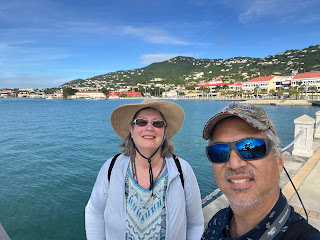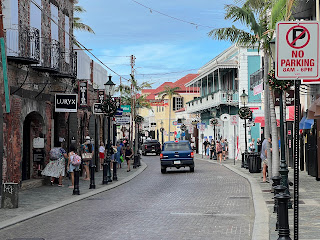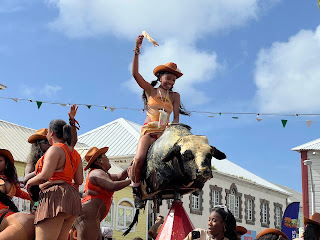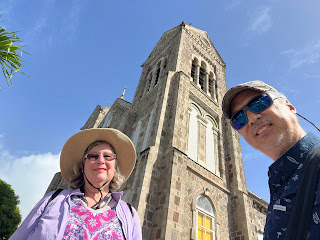20241230 Monday December 30, 2024; The Long Trip Home
Disembarkation from the ship went smoothly. John had to disembark by 7am to make his airport transfer.
The rest of us got out of our staterooms by 8am and hung out in the Take 5 Lounge for Elite disembarkations where they had pastries, coffee and tea. We got the go ahead to head ashore at 9am. There was a bit of a wait in line clearing customs, but that was no more than 10 or 15 minutes to get through. The bus transfer to the airport was also easy enough. There were enough empty seats on the bus that we could spread out just a little bit. Price and Ben got to have a row to themselves, but one of the very last ladies to come aboard squeezed in with Janet. It looked like there was actually still one empty row further back in the bus when everyone was loaded on.
The biggest headache for us was getting to the airport at 10am, but not being able to check in our luggage until 2PM for our 6:40PM flight departure time. The Fort Lauderdale airport was not set up for this because there are inadequate waiting areas on the ticketing side of the airport, and almost no services (restaurants and shops). There was a bag storage service in one corner of the building that charged $10 per bag, which is pretty exorbitant.
Ben had contemplated renting a small SUV so we could relax outside the airport and get something to eat while being able to store the bags in the car, but we ended up finding a couple of seats and snagged an abandoned luggage trolley to park our bags on. The airport did have wifi. We took turns walking the terminal buildings which span nearly a mile from one end of Terminal 1 to the other end of Terminal 4 to get our steps in for the day.
Once an announcement was made that people with 6PM flights could check their luggage, we made a beeline to the counter and got all our bags checked. Janet and Ben could each check one free bag because they have the Delta Airlines American Express card, but because the flight was nearly full, they also allowed us to check all our carryon suitcases for free, including Price. This made getting around the airport easier.
The Fort Lauderdale airport has CT luggage scanners that can slice through luggage from top to bottom, allowing them to see through multiple layers of items in a bag. While this can detect more items, it is significantly slower than the conventional conveyor belt X-ray scanners. Our TSA Pre-Check status allowed us to keep our shoes on and laptops did not have to be removed from our bags. Janet’s TSA Pre-Check anomaly had been resolved on the outbound leg so she sailed through this time without a hitch.
The terminal gates at Fort Lauderale seemed to be operating at near capacity. We were eventually able to find seating and did manage to get some burgers, fries and shakes a the Shake Shack in the terminal. There was a very limited selection of dining options. We were disappointed not to see a Burger King or McDonalds. Besides the Shake Shack, there were two pizza/meatball sandwich places, a sushi bar, and a Starbucks. There was also a general store with cold wrapped sandwiches and bottled drinks alongside overpriced souvenirs and travel essentials.
Our flight departed right on time and was pretty smooth sailing. We booked in Premium Economy which gives enough leg room that it is possible to pick something up off the floor if you drop something. Not nearly as nice as international business class, but bearable for the 6 hour flight. There were meals available for purchase at the start of the flight. Smart people had brought their own sandwiches on board. We didn’t think to smuggle sandwiches out of the International Cafe for this purpose, but that would have been smart, and unlike in all the other ports of call, there was no prohibition to taking food off the ship. We did see other families in the airport who had done that. Next time.
Because we were flying westbound, our flight arrival at 9:55PM theoretically wasn’t that late, but since we were essentially on Eastern Standard Time, it was 1AM for us. By the time we got to the car with our luggage, it was 11:30PM and we found most of the fast food outlets around the airport drive to be close after passing a McDonalds that had a back up out onto highway 99. We ended up stopping in Marysville where we found an open Burger King. We were grateful for the food, although it definitely had been sitting under a heat lamp for many hours. We topped off the gas tank at the Angel of the Winds Casino, but then drove straight home, arriving around 1am, which would be 4am EST. We pretty much just dragged ourselves upstairs and collapsed into our beds.
Invariably, we seem to need a vacation to recover from our vacations, but in retrospect we did have a very enjoyable Christmas trip with John and Price where we got to be spoiled by the Princess Cruises staff at every turn. It’s hard to beat a Christmas cruise for putting together inclusive food, entertainment, travel and lodging with minimal fuss. We look forward to doing it again next year, but with the entire family and Tom’s family as well.














.jpeg)


























.jpeg)






.jpeg)










.jpeg)



.jpeg)